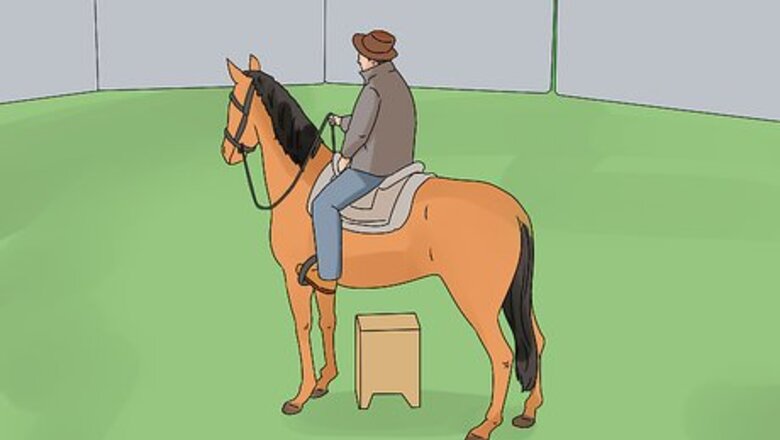
views
Walking a Horse
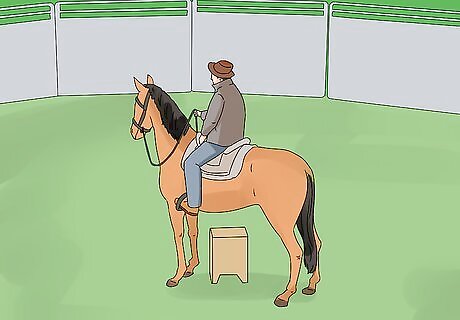
Take your horse into a ring and mount it. When learning to walk your horse, it’s a good idea to work with the animal in a contained area, such as a ring. Get up onto your saddle by using mounting blocks or pulling yourself up onto the horse. When you are on the horse in the ring, you can control its movement better than if you were out in a pasture.Tip: Before getting on a horse, check that the saddle is tight. A loose saddle could cause you to fall off the horse.
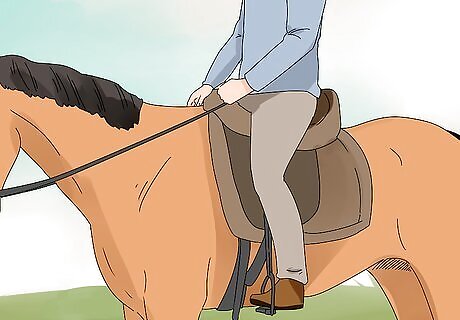
Position yourself correctly on the horse. Sit upright and put your feet in the stirrups, if you are using them. Even when having your horse walk at a slow pace, you should have proper posture while on your horse. Be sure that your head is lined up directly above your spine and hips, forming a straight line. If you are using stirrups, make sure the ball of your foot is on the stirrup. Hold the reins so that they are taut but not tight. There should not be any slack in them but you should not be pulling on the horse’s head either. Having proper posture will make riding more comfortable for you and your horse.
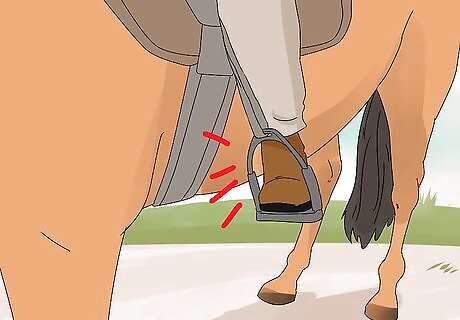
Ask the horse to move by giving it a light squeeze with your lower legs. This should be a quick movement done right where your legs are positioned in the stirrups. Release your leg pressure from the horse as it starts moving. The walk is a slow gait with a gentle rocking motion. In the walk, the horse steps with its left hind leg, left front leg, right hind leg, and then right front leg. This makes the walk a four-beat gait, which means you can count 1-2-3-4 as you walk. Since you want the horse to move freely, you need to take leg pressure off of it as soon as it starts moving. If you continue to apply pressure, the horse will think that you want it to go quicker.
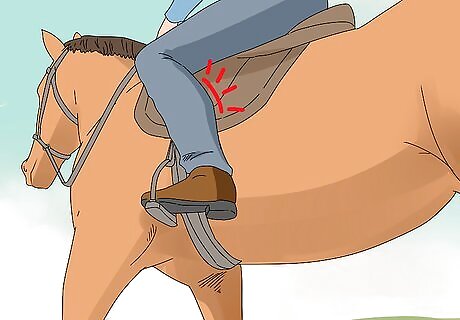
Give another gentle squeeze if the horse slows down. To keep your horse going forward, give it a short, brisk squeeze with your legs. If it's being particularly lazy, you can give it a quick, purposeful squeeze with your calves. As your horse is moving, you don’t want to grip the horse with your legs. This will slow the horse down. You want to keep your balance with your feet in the stirrups and your sits bones, which are the bones at the bottom of your pelvis, on the saddle. The walk has the least natural forward movement of all three gaits, which means that you often have to encourage your horse to keep moving at this speed.

Focus on keeping your posture upright but relaxed. At the walk, you must keep the muscles in your upper body supple and relaxed, so that they absorb the horse's motion. Don't let your seat or lower leg slip. Because the horse swings its head at the walk, allow your hands to gently move back and forth with the movement.
Riding at a Trot
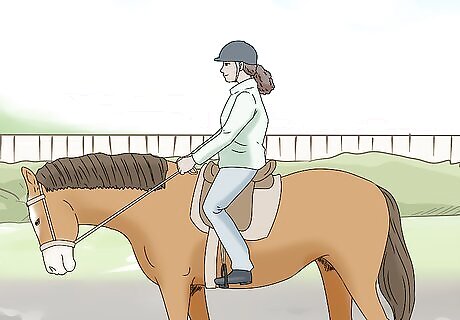
Sit up tall in your saddle. To keep upright and balanced, place the balls of your feet in your stirrups, if you are using them, and have your sits bones planted on the saddle. Your head, shoulders, spine, hips, and sits bones should all be in a straight line. Your body position should be the same whether you are riding English or Western style.
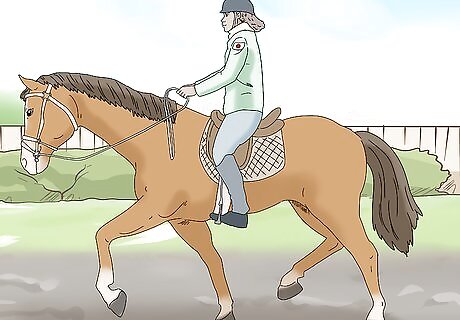
Start in a walk so you can transition to trotting. When learning to ride a horse at a trot, it’s easiest to start the horse walking and then work up to a trot. Get the horse moving by squeezing your lower legs briefly. This slow movement will allow the horse to get used to you and will allow you to prepare for the trotting movement. Once you have mastered the trot and you have gotten to know the horse you are riding, you will not always have to purposely transition from a walk to a trot.
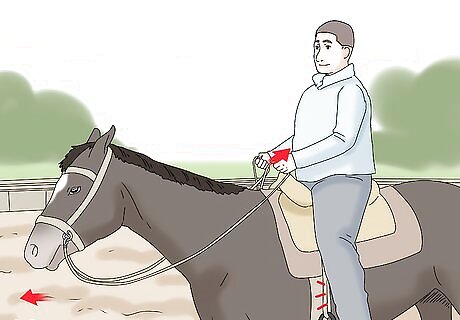
Tell the horse to trot by squeezing your legs and gently pulling the reins. Give the horse a couple brisk squeezes with your lower legs. At the same time, shorten the reins by 1–2 inches (2.5–5.1 cm). This small amount of tension on the reins is more than enough to tell the horse to go without putting too much tension on its mouth. The pressure you apply with your legs should be temporary. Don’t keep the pressure on or it will send a mixed message and actually slow the horse down.
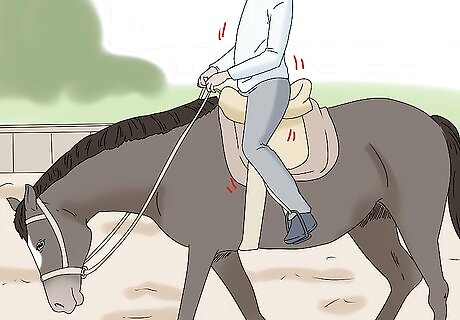
Absorb the movement of the horse. Keep your hips, knees, and ankles supple and springy, and absorb the movement through your seat. Imagine that you are melting down into the saddle, so that your seat becomes deep and heavy. In the trot, the horse steps with diagonal pairs of legs. For example, the left hind leg and right foreleg move together. The trot is considered a two-beat gait.
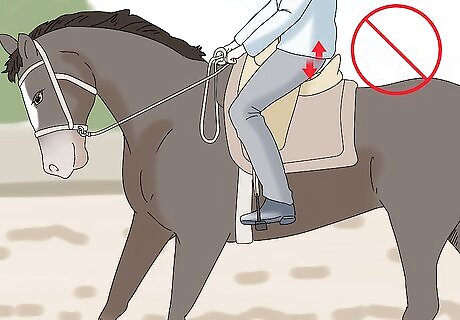
Avoid bouncing in the saddle. A common problem for riders during trotting is that their bodies want to bounce out of the saddle as the horse goes up and down. To ride the trot correctly, you don’t want to fight the rise and fall of the horse. Instead, keep your posture straight and move along with the horse, instead of against it. The bouncing can be hard on the rider and the horse, so you need to learn how to avoid it.
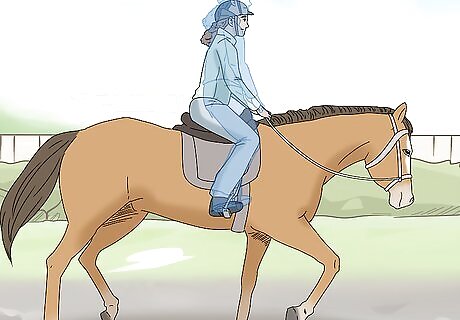
Try posting once you have practice with the trot. Posting is a rising and falling riding technique that only works when you can sit the trot comfortably. To post, you rise up with one beat of the trot, and sit down the next. Keep an even pressure on your stirrups, and allow the horse to move you. Posting is a more advanced technique that may take some time to perfect. It’s important to be skilled at trotting the horse and sitting during the trot before trying to post in the trot.Tip: Posting is typically done by those riding English style. If you are doing another style, you typically don't have to worry about doing this kind of riding.
Cantering Your Horse

Distinguish the canter from the walk and the trot. The canter is three-beat gait with a rocking motion. This is a quicker speed than walk and trot that also requires greater balance on the rider’s part, so it should only be done after you have mastered the walk and the trot. During the canter, the horse moves its right rear leg, then its left rear and right front legs, and then the left front leg. The right rear leg will move again a moment later.
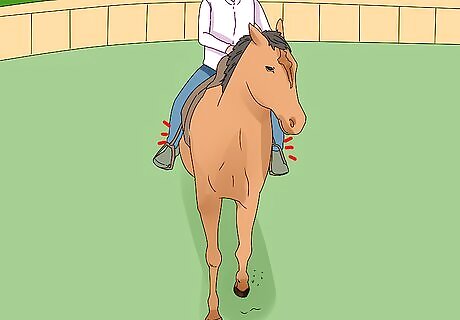
Build up to a canter by starting at a trot. It is important that your horse is moving with impulsion before you ask for it to canter. Get the horse walking with a quick squeeze of the lower legs and then get it into a trot with another squeeze and light pressure on the reins. Having your horse moving at a trot will allow for an easier transition to a new gait. Transitioning from a trot to a canter can take some practice to perfect. Don’t be discouraged if it is awkward at first. You and your horse just need to work on your communication and timing.
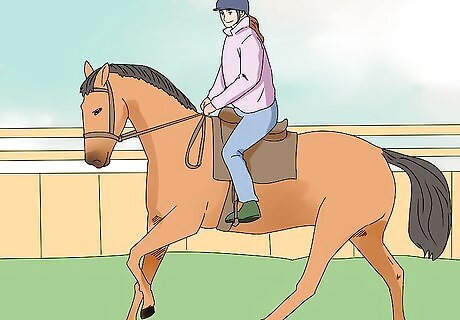
Tell your horse to canter by putting pressure on its girth and reins. To transition from trot to canter, sit down in the saddle and deepen your seat, which means that you need to tilt your body forward just slightly so more of your sits bones have contact with the saddle. Then move just your outside leg back slightly and squeeze that leg into the horse’s girth. At the same time as you are squeezing, put a small amount of pressure on the inside reins. Your outside leg is the leg that is closest to the side of the ring you are in. You should also pull your inside rein slightly to offset the pressure you are applying with your outside leg. Applying pressure to one side of the reins and the other side of the girth helps to keep the horse moving in a straight line.Tip: As with all of these riding speeds, you want to keep your body position upright and in alignment.

Focus your energy on keeping your seat grounded on the saddle. Once you've begun cantering, allow your seat to deepen and follow the horse’s movement. Imagine that you are cleaning the saddle with your seat: allow it to move in slow, steady circles. It’s important not to sit back in the saddle while you are trying to keep your seat grounded. Leaning back will slow the horse down, so be sure to keep your body in alignment and grounded but just slightly forward.










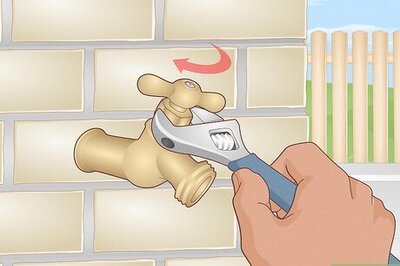




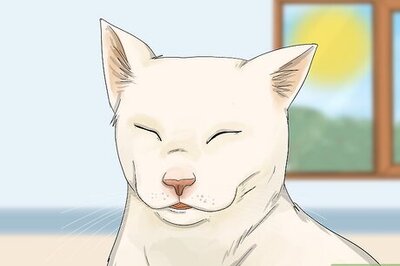
Comments
0 comment